2. 东华理工大学地球科学学院, 南昌 330013;
3. 青海省核工业地质局, 西宁 810001
2. School of Earth Sciences, East China University of Technology, Nanchang 330013, China;
3. Qinghai Nuclear Industry Geological Bureau, Xining 810001, China
海德乌拉地区位于青海都兰县境内,大地构造位置处于东昆仑造山带东部(图 1; Dong et al., 2018a)。根据铀矿勘探资料,在海德乌拉火山岩内已经厘定具有工业意义的钻孔若干,圈定铀矿化带若干,铀矿加权平均品位达到富矿范畴(0.5%~1.0%为富矿范畴)。众所周知,中国境内的火山岩型铀矿床主要发育在中国东部地区,如赣-杭成矿带、武夷山成矿带、沽源-红山子成矿带(巫建华等, 2014, 2017)。海德乌拉火山岩型铀矿床是我国西北地区厘定的首个与火山岩有关的独立铀矿床,具有十分重要的科研及找矿意义。
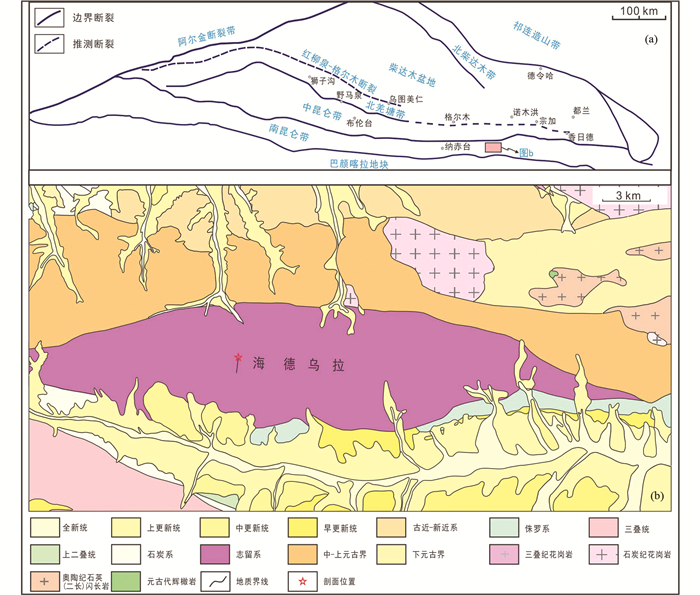
|
图 1 东昆仑造山带构造简图(a, 据Dong et al., 2018a修改)和海德乌拉火山岩区地质简图(b) Fig. 1 Simplified tectonic map of the East Kunlun Orogenic Belt (a, modified after Dong et al., 2018a) and simplified geological map of the Haidewula volcanic rock area (b) |
此外,作为青藏高原北部重要的地质构造单元,东昆仑造山带一直以来备受地质学家的关注(Dong et al., 2018a及其中的参考文献)。作为冈瓦纳超大陆和欧亚大陆之间一个重要的边界,东昆仑造山带是一个经历多期构造活动的复杂造山带,记录了晚新元古代-早古生代和晚古生代-新生代两期次造山作用,分别表征了原特提斯洋和古特提斯洋的形成和演化(古凤宝, 1994; 丰成友等, 2004; Song et al., 2018; Dong et al., 2018a, b )。前人通过对早古生代镁铁质-超镁铁质岩、中酸性侵入岩和相关的沉积建造等研究,指出东昆仑早古生代为一套与原特提斯洋有关的俯冲-增生造山作用(Dong et al., 2018a)。然而,对于原特提斯洋的晚阶段演化依旧存在争议,主要在于原特提斯洋是否最终在志留-泥盆纪闭合(Song et al., 2018; Chen et al., 2020),或是被长时间俯冲的古特提斯洋所继承(Dong et al., 2018a; Zhou et al., 2016)。
鉴于此,本文对海德乌拉地区酸性火山岩进行了详细的野外地质调查研究,并选取典型岩石开展锆石U-Pb-Hf同位素研究和岩石地球化学研究,探讨海德乌拉地区酸性火山岩的成因及成岩大地构造背景,寄望为东昆仑造山带古生代构造演化及铀成矿作用提供新的依据。
1 地质背景及岩相学特征昆仑造山带位于青藏高原北缘(图 1a),夹持于北中国板块群与南中国板块群之间,是中国大陆巨型构造带——中央造山带的重要组成部分(许志琴等, 2006)。昆仑造山带东西向延伸约2500km,其西部与帕米尔高原连接,东部与秦岭造山带接壤(Dong et al., 2018a)。该造山带不仅记录了新生代青藏高原的快速隆起(Yin and Harrison, 2000),而且充分保留了塔里木、柴达木和羌塘板块之间俯冲与碰撞以及古特提斯洋闭合的信息(Şengör, 1979; Molnar et al., 1987a, b ; Roger et al., 2003)。以中生代-新生代的阿尔金走滑断裂为界,昆仑造山带可划分为东昆仑造山带和西昆仑造山带。东昆仑造山带反映了柴达木和羌塘板块之间的俯冲增生造山作用,西昆仑造山带由塔里木和羌塘板块构成(Dong et al., 2018a)。
以昆中缝合带和昆南缝合带为界,东昆仑造山带可以分为北祁漫塔格带、中昆仑带、南昆仑带以及巴颜喀拉地体。海德乌拉地区位于南昆仑带内,南昆仑带主要由古生界-三叠纪沉积或火山岩组合的不连续逆冲推覆带构成,发育少量的前寒武纪变质岩和早古生代岩体碎片。前寒武纪单元主要包括古元古代苦海群和中-新元古代万宝沟群。苦海群主要包括片麻岩、片岩、角闪岩和大理岩,其原岩主要由碎屑岩、火山岩和碳酸盐岩构成。万宝沟群主要由低级变质作用的玄武质安山岩和碳酸盐岩夹碎屑岩构成。志留纪赛什腾组主要由砾岩、砂岩、少量火山岩和凝灰岩组成。中泥盆世地层主要由火山碎屑岩和碳酸盐岩构成。晚泥盆世地层由滨海-浅海相沉积构成,包括砂岩、粉砂岩夹灰岩和少量细粒砾岩。石炭纪和二叠纪地层主要由砾岩、砂岩、粉砂岩、泥岩和灰岩构成。三叠纪地层由砾岩、砂岩、玄武质安山岩、灰岩和泥岩构成。
东昆仑造山带内岩浆作用较强烈,主要包括早古生代、二叠-三叠纪侵入岩及奥陶-志留纪纳赤台群火山岩。侵入岩主要为闪长岩、花岗闪长岩和花岗岩。纳赤台群火山岩主要为玄武质安山岩、英安岩、流纹岩、火山碎屑岩和浊积岩与少量灰岩互层。海德乌拉火山盆地显示扁长型形态,东西延伸约30km,南北最长延伸约7km(图 1b)。区内火山岩北侧与中元古代呈断层接触,南侧发育有大量第四纪、第三纪和新近纪的红色碎屑沉积物。海德乌拉火山盆地内区内发育一套中性-酸性火山岩-次火山岩组合。该套火山岩最初被认为形成于晚三叠世(青海省地质矿产局, 1991),朱云海等(2003)认为海德乌拉火山岩为侏罗纪多次喷发旋回火山作用,岩性为基性-中性-酸性火山熔岩及火山碎屑岩组合,岩性主要有玄武岩、粗安岩、粗面岩、流纹岩、含晶屑凝灰岩及火山角砾岩等,夹有红色砂岩、粉砂岩。
本次研究选择酸性火山岩发育的地区进行剖面测量并采集典型的样品进行测试分析。笔者实测剖面从北向南结果依次为(图 2:GPS位置:35°53′24″N、95°56′37″E):(1)紫红色集块岩和火山角砾岩,延伸近10m;(2)块状流纹岩和石泡流纹岩,延伸近240m;(3)紫红色砂岩-粉砂岩,延伸约46m,产状180°∠70°;(4)灰绿色辉绿岩,延伸近62m;(5)紫红色厚层状砂岩-粉砂岩,延伸近57m,产状186°∠73°;(6)灰黑色辉绿岩,延伸近30m;(7)紫红色砂岩-粉砂岩,沿走向延伸约12m,产状178°∠76°;(8)灰绿色粗面岩-粗安岩,沿走向延伸近19m;(9)紫红色流纹岩,延伸近68m;(10)紫红色砂岩-粉砂岩,延伸约22m,产状180°∠73°;(11)灰绿色辉绿岩,延伸约34m;(12)紫红色砂岩-粉砂岩。本次研究选择海德乌拉流纹岩作为研究对象。流纹岩包括深灰色流纹岩(图 3a)、紫红色流纹岩(图 3b)和紫红色石泡流纹岩(图 3c),具有斑状结构和球粒结构(图 3),流纹构造(图 3b)和石泡构造(图 3c)发育。其中深灰色流纹岩和紫红色流纹岩斑晶含量约5%,而石泡流纹岩斑晶含量较少。斑晶主要为碱性长石(图 3d)和石英(图 3e),碱性长石斑晶表面泥化,石英斑晶发育有熔蚀反应边。基质普遍具有球粒结构(图 3f),少量发育显微文象结构(图 3e)。副矿物包括锆石、磷灰石、磁铁矿等。
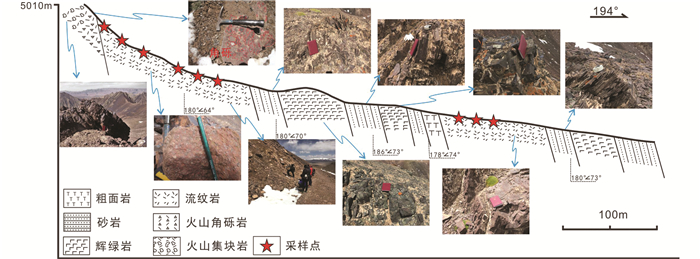
|
图 2 海德乌拉地区地层剖面图 Fig. 2 Stratigraphic section in the Haidewula area |
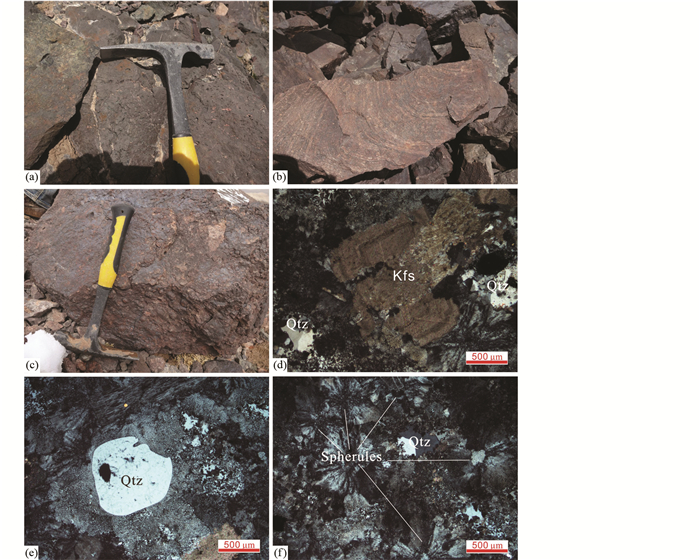
|
图 3 海德乌拉流纹岩岩相学特征 (a)深灰色流纹岩;(b)紫红色流纹岩流动构造;(c)紫红色石泡流纹岩;(d)钾长石斑晶和基质球粒结构;(e)石英斑晶、基质球粒结构和文象结构;(f)流纹岩基质球粒结构.Qtz-石英;Kfs-钾长石;Spherules-球粒结构 Fig. 3 Field and microscopic photographs of the Haidewula rhyolite (a) dark gray rhyolite; (b) flow structure of purplish-red rhyolite; (c) purplish red lithophysa rhyolite; (d) plagioclase phenocryst and matrix spherulite structure; (e) quartz phenocryst, matrix spherulite structure and graphic texture; (f) Spherulite structure of rhyolite matrix. Qtz-quartz; Kfs-K-feldspar; Spherules-matrix spherulite structure |
在手工破碎、淘洗、磁选和重液分选基础上,选择具有代表性的锆石制成样品靶。在开始锆石U-Pb同位素分析前,先进行阴极发光(CL)图像分析,以确定锆石颗粒的内部结构。锆石U-Pb同位素分析检测在南京聚谱检测科技有限公司完成。其中激光剥蚀系统为193nm ArF准分子激光剥蚀系统,型号为RESOlution LR。四极杆型电感耦合等离子体质谱仪(ICP-MS)由安捷伦科技(Agilent Technologies)制造,型号为Agilent 7700x。测试过程中以标准锆石91500(1062Ma)为外标,校正仪器质量歧视与元素分馏;以标准锆石GJ-1(600Ma)与Plešovice(337Ma)为盲样,检验U-Pb定年数据质量。原始的测试数据经过ICPMSDataCal软件离线处理完成(Liu et al., 2010)。
LA-MC-ICP-MS Hf同位素测试过程中多接收器型号电感耦合等离子体质谱仪(MC-ICP-MS)由英国Nu Instruments公司制造,型号为Nu Plasma Ⅱ。测试过程中每隔5颗锆石样品,依次测试一颗标准锆石(包括GJ-1、91500、Plešovice、Mud Tank、Penglai),以检验锆石Hf同位素比值的数据质量。
2.2 主量和微量元素测试方法全岩主微量元素测定在南京聚谱检测科技有限公司完成。取40mg全岩粉末置于聚四氟乙烯溶样弹中,加入0.5mL浓硝酸与1.0mL浓氢氟酸,溶样弹经钢套密封后放入195℃烘箱加热3天,确保彻底消解。盛放消解液的溶样弹在电热板上蒸至湿盐状,加入6mL 20%硝酸,重新密闭溶样弹,放入195℃烘箱过夜。约6mL消解液转移至离心管中,经天平称重。取一部分适当稀释(相对于固体重量,稀释因子2000倍),以雾化形式送入Agilent 7700x ICP-MS测定微量元素;取另一部分适当稀释(相对于固体重量,稀释因子500倍),以雾化形式送入Agilent 5110 ICP-OES测定除Si以外的主量元素。称取40mg全岩粉末置于银坩埚中,加入120mg氢氧化钠粉末,均匀混合,在马沸炉熔融。熔融物经盐酸中和,转移至离心管中,经天平称重。取另一部分适当稀释(相对于固体重量,稀释因子1000倍),以雾化形式送入Agilent 5110 ICP-OES测定Si元素。与德国马普学会地质与环境标物数据库GeoReM(Jochum and Nohl, 2008)对比,这些地质标物的实测值固体浓度大于10×10-6的微量元素,偏离范围不超过±10%;固体浓度大于50×10-6的微量元素,偏离范围不超过±5%。
3 分析结果 3.1 年代学特征海德乌拉流纹岩(HDWL-5、HDWL-7) 锆石LA-ICP-MSU-Pb同位素定年结果见表 1。被测样品锆石的CL图像均显示出明显的振荡环带(图 4),并具有高的Th/U比值(0.46~0.95),表明均是典型的岩浆锆石(吴元保和郑永飞, 2004)。
|
|
表 1 海德乌拉流纹岩锆石U-Pb同位素组成 Table 1 Zircon U-Pb isotopic compositions of the Haidewula rhyolites |

|
图 4 海德乌拉流纹岩锆石SEM-CL结构、U-Pb定年和Hf同位素点位测试图 白色实线圈代表锆石U-Pb同位素定年点位,虚线圈代表锆石Hf同位素测试点位 Fig. 4 Zircon SEM-CL structure, U-Pb dating, and Hf isotope point position test diagrams of the Haidewula rhyolite The white solid lines circle represents the U-Pb isotopic dating point of zircon and the dashed lines circle represents the Hf isotopic testing point of zircon |
样品HDWL-5被测锆石的数据点均在谐和线上(图 5a),被测锆石206Pb/238U年龄数据均落在419~435Ma范围内,加权平均年龄为426.1±3.0Ma (MSWD=0.54),为该样品的结晶年龄(图 5b)。
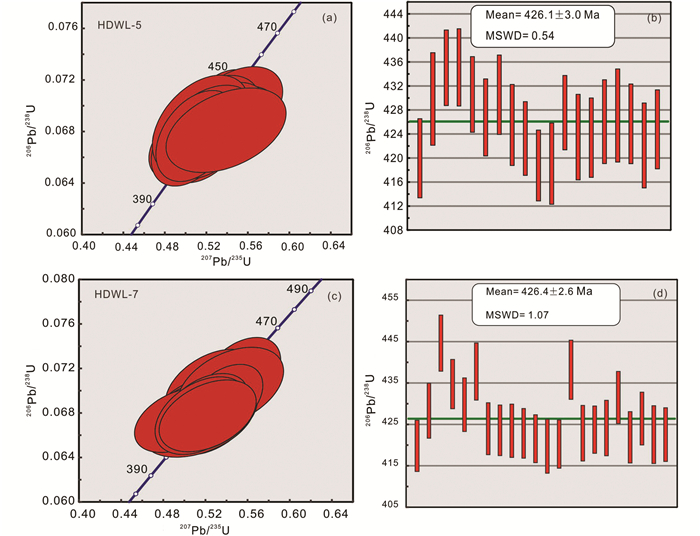
|
图 5 海德乌拉流纹岩锆石LA-ICP-MS U-Pb同位素定年谐和图 Fig. 5 Zircon LA-ICP-MS U-Pb isotope concordia diagrams of the Haidewula rhyolites |
样品HDWL-7被测锆石的数据点均在谐和线上(图 5c),被测锆石206Pb/238U年龄数据均落在420~445Ma范围内,加权平均年龄为426.4±2.6Ma (MSWD=1.07),为该样品的结晶年龄(图 5d)。
锆石测年结果表明,海德乌拉地区火山岩为古生代志留纪罗德洛世岩浆作用的产物。
3.2 地球化学特征样品全岩地球化学分析结果和相关参数见表 2。海德乌拉流纹岩主量元素特征可以归纳为:(1)富SiO2(73.17%~77.96%),属于高硅流纹岩系列;(2)富碱(K2O+Na2O含量介于7.21%~8.86%之间,平均值为8.00%);(3)相对富钾(K2O/Na2O介于0.92~2.69之间,平均值为1.71),属于高钾钙碱性至钾玄岩系列(图 6a, b);(4)富铝,A/CNK值为1.04~1.14,属于过铝质-强过铝质岩石系列(图 6c);(6)富铁(FeOT=0.66%~2.46%)且相对贫镁(MgO=0.07%~0.16%),FeOT/MgO比值介于8.23~22.57之间,属于铁质岩石系列(图 6d)。
|
|
表 2 海德乌拉流纹岩主量(wt%)及微量(×10-6)元素组成 Table 2 Major (wt%) and trace (×10-6) element compositions of the Haidewula rhyolites |
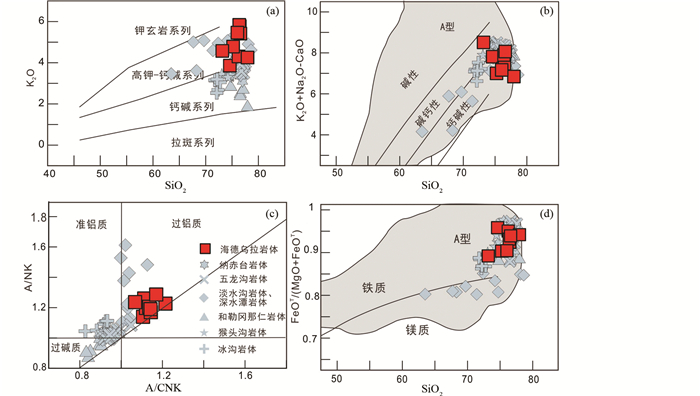
|
图 6 海德乌拉流纹岩主量元素特征图 (a) K2O-SiO2图解(Peccerillo and Taylor, 1976);(b) (K2O+Na2O-CaO)-SiO2图解(Frost et al., 2001);(c) A/NK-A/CNK图解(Maniar and Piccoli, 1989);(d) FeOT/(FeOT+MgO)-SiO2图解(Frost et al., 2001). 数据来源:猴头沟(严威等, 2016),淡水沟、深水潭(Chen et al., 2020),五龙沟(Xin et al., 2018),和勒冈那仁(Li et al., 2013),纳赤台(陈有炘等, 2013),冰沟(刘彬等, 2013a). 图 7、图 9、图 11数据来源同此图 Fig. 6 Major element diagrams of the Haidewula rhyolite |
海德乌拉流纹岩具有较高的稀土元素总量(310.0×10-6~456.8×10-6)。在球粒陨石标准化稀土元素配分图上呈现右倾的稀土配分模式(图 7a),轻、重稀土分异明显且相对富集轻稀土((La/Yb)N=6.13~14.23),具有强烈的负Eu异常(δEu=0.03~0.06)。在微量元素原始地幔标准化的配分图解中(图 7b),样品均富集Th和U等元素,亏损Nb、Ta、Ti、Ba、Sr和Eu等元素,各样品中元素的富集与亏损程度都有所不同。

|
图 7 海德乌拉流纹岩球粒陨石标准化稀土元素配分图(a)和原始地幔标准化微量元素蛛网图(b) (标准化值据McDonough and Sun, 1995) Fig. 7 Chondrite-normalized REE patterns (a) and primitive mantle-normalized trace element spider diagrams (b) of the Haidewula rhyolite (normalization values after McDonough and Sun, 1995) |
在U-Pb同位素年龄可靠的基础上,对锆石开展原位Lu-Hf同位素测定。锆石Hf测定点位见图 4,对应的Hf同位素组成及相关参数见表 3。海德乌拉流纹岩锆石Hf同位素初始值(176Hf/177Hf)i介于0.282537~0.282583之间,相对应的εHf(t)值介于+0.60~+2.39之间,与东昆仑造山带奥陶纪-志留纪A型花岗岩类似(图 8a),对应的二阶段Hf同位素模式年龄(tDM2)介于1285~1370Ma之间。在锆石εHf(t)频率直方图上(图 8b),海德乌拉流纹岩具有单峰锆石Hf同位素组成。
|
|
表 3 海德乌拉流纹岩锆石Hf同位素组成 Table 3 Zircon Hf isotopic compositions of the Haidewula rhyolites |
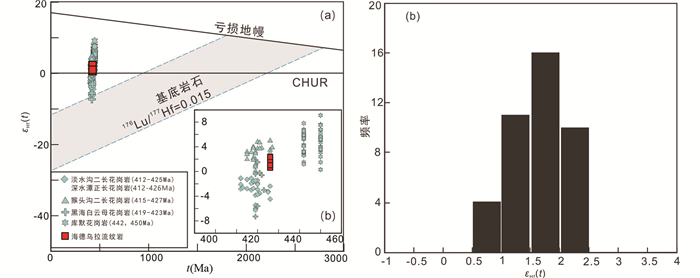
|
图 8 海德乌拉流纹岩锆石Hf同位素组成图 数据来源:淡水沟、深水潭(Chen et al., 2020),猴头沟(严威等, 2016),黑海(施彬, 2014),库默(Dong et al., 2018b) Fig. 8 Zircon Hf isotopic composition diagrams of the Haidewula rhyolite |
自Loiselle and Wones (1979)提出后,A型岩浆岩以其特有的特征,如富碱的、无水的和非造山的,形成于独特的构造背景而被沿用至今。传统而言,A型岩浆岩具有标志性的组成矿物——碱性暗色矿物,如钠闪石-钠铁闪石、霓石-霓辉石、铁橄榄石等;且具有独特的地球化学特征,如高的Fe/(Fe+Mg)、Al/(K+Na)、K/Na以及Ga/Al比值、亏损镁铁质硅酸盐(Sc、Cr、Ni)以及长石(Ba、Sr、Eu)之类的相容元素、富集大离子亲石元素和高场强元素(Collins et al., 1982)。然而,随着对A型岩浆岩深入的研究,其特征也相应的发生了一些变化,如部分A型岩浆岩并不贫水,且一些A型岩浆岩显示出准铝质系列和过铝质特征(Sun et al., 2011; Wang et al., 2013; Zhao et al., 2013),此外部分A型岩浆岩可形成于后造山环境(Eby, 1990, 1992; Bonin, 2007)。
海德乌拉流纹岩具有高SiO2含量,属于高演化岩浆岩序列。前人研究认为高演化的A型、S型和I型岩浆岩能表现出相似的地球化学特征。相对而言,高演化的S型花岗岩具有较高的P2O5含量(P2O5的平均值是0.14%,King et al., 1997),高演化的I型花岗岩具有较低的FeOT含量(一般低于1%,贾小辉等,2009)。海德乌拉流纹岩具有低的P2O5含量(0.01%)和高FeOT含量(0.66%~2.46%),排除了海德乌拉流纹岩属于高分异的I型和S型岩浆岩的可能性。在Whalen et al. (1987)的判别图解中,海德乌拉流纹岩样品均投落在A型岩浆岩的区域内(图 9a-d),因此认为海德乌拉地区流纹岩为A型流纹岩。
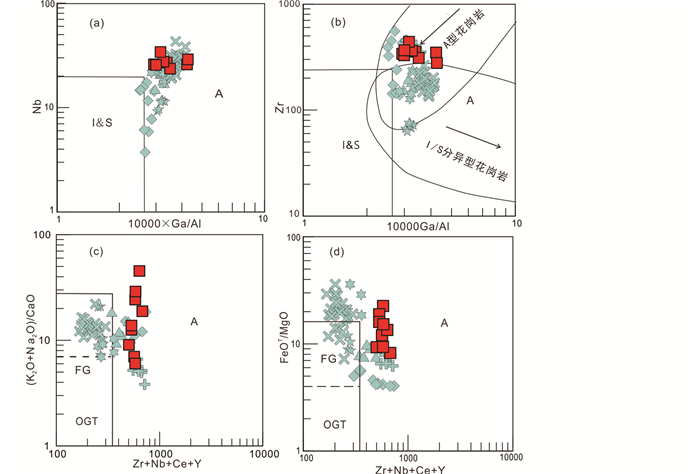
|
图 9 海德乌拉流纹岩类型判别图(据Whalen et al., 1987) Fig. 9 Discrimination diagram of rhyolite type in Haidewula (after Whalen et al., 1987) |
海德乌拉流纹岩的TiO2含量为0.12%~0.16%,Al2O3/TiO2比值为88.7~107.6。研究表明,在泥质岩和岩屑砂岩的熔融过程中,由于富Al2O3矿物(白云母和斜长石)的稳定性,随着温度的升高,熔体中Al2O3含量变化不大;而富TiO2的矿物,如黑云母和钛铁矿,会随温度的升高而加速分解,导致熔体中TiO2含量迅速上升。因此,高温环境下熔体的Al2O3/TiO2比值会偏低。由此可见,海德乌拉流纹岩熔体的形成温度较高。这一结论也与海德乌拉流纹岩样品锆石饱和温度(856~887℃)吻合(表 2)。
4.2 岩石成因目前,关于A型岩浆岩的形成机制有多种不同的见解,其中以下三种观点被大多数人所认同:幔源岩浆的结晶分异作用(Eby, 1992)、幔源岩浆与壳源岩浆的混合作用(Yang et al., 2006)以及地壳物质的部分熔融等(Patiño Douce, 1997; Skjerlie and Johnston, 1992)。
幔源玄武岩熔体的结晶分异作用通常产生过碱性岩浆(King et al., 1997; Patiño Douce, 1997),这与海德乌拉流纹岩过铝质的特征不一致。此外,幔源玄武岩熔体结晶分异作用所形成的酸性岩在时间上和空间上往往与大量基性和中性岩浆岩密切相关(Litvinovsky et al., 2002; Turner et al., 1992)。在海德乌拉地区发育着大面积流纹岩,与之相比同时期的基性岩出露面积较小。因此,海德乌拉A型流纹岩并非源于幔源岩浆的结晶分异作用。
缺乏镁铁质暗色微粒包体和地球化学成分有限变化说明海德乌拉流纹岩由岩浆混合作用形成的概率较低。壳-幔岩浆混合作用产生的岩浆具有相对分散同位素的特征(Griffin et al., 2002; Kemp et al., 2007),然而海德乌拉流纹岩锆石Hf同位素组成显示了单峰的特征(图 8b),这也不支持它们为壳-幔混合成因。此外,海德乌拉流纹岩显示高SiO2含量(73.17%~77.96%)、强过铝质、MgO含量低(0.06%~0.16%)、相容性元素含量低(Cr:0.22×10-6~8.66×10-6、Ni:0.40×10-6 ~4.81×10-6、Co:0.04×10-6~0.20×10-6)等特征,也表明幔源物质对其形成的影响不明显。
海德乌拉流纹岩样品Nb/U和Ce/Pb平均比率为5.1和9.7,与原始地幔(30和9)、OIB(47±10和25±5)的Nb/U和Ce/Pb比值差异明显,与大陆地壳的Nb/U和Ce/Pb比值近似(10和4,Hofmann et al., 1986),暗示海德乌拉A型流纹岩与地壳有密切关系。
不同地壳组成的部分熔融都可以产生A型岩浆岩,如变质沉积岩(Collins et al., 1982)、之前抽离了花岗质熔体中的无水下地壳残留体(Collins et al., 1982; King et al., 1997; Whalen et al., 1987)、新形成的镁铁质下地壳(Frost et al., 1999, 2001)以及浅部地壳中的长英质岩石(Creaser et al., 1991; Frost and Frost, 2011; Patiño Douce, 1997; Wu et al., 2002; Zhou et al., 2014)等。尽管海德乌拉A型流纹岩具有变质沉积岩部分熔融产生的熔体的强过铝质等特征(Chappell, 1999; Huang et al., 2011),然而海德乌拉流纹岩锆石的εHf(t)值不同于东昆仑基底Hf同位素组成的演化域,也明显高于东昆仑造山带内由变质沉积岩部分熔融而成古生代S型花岗岩的εHf(t)值(-6.7~0.7),说明海德乌拉A型流纹岩并非源于变质沉积岩的部分熔融。
贫水下地壳部分熔融形成的岩浆岩具有低TiO2/MgO和(Na2O+K2O)/Al2O3比值、低SiO2含量、高CaO和Al2O3含量等特征(Creaser et al., 1991; Frost and Frost, 1997; Patiño Douce, 1997)。然而,海德乌拉A型流纹岩具有高TiO2/MgO(0.71~1.79,平均为1.19)比值、高(Na2O+K2O)/Al2O3(0.79~0.89,平均为0.84)比值和高SiO2(73.17%~77.96%)含量,与贫水下地壳残留部分熔融形成的岩浆岩不一致。
海德乌拉A型流纹岩的高K2O含量(3.86%~5.84%),暗示它们可以通过新生镁铁质下地壳的部分熔融形成(Dall'Agnol et al., 1999; Frost et al., 1999, 2001)。然而,实验研究表明铁镁质下地壳物质部分熔融形成的岩浆岩一般为准铝质且K2O/Na2O比值小于1(Dall'Agnol et al., 1999; Rapp and Watson, 1995; Lopez and Castro, 2001; Xiao and Clements, 2007)。尽管部分实验研究证明当压力大于15kbar时,铁镁质岩石部分熔融能产生过铝质且K2O/Na2O比值大于1的熔体,然而该压力环境下形成的富钾岩浆岩一般都具有埃达克质岩的特征(Rapp and Watson, 1995; Skjerlie and Patino Douce, 2002)。此外,镁铁质下地壳部分熔融不可能产生大面积高硅熔体(SiO2>70%, Rapp and Watson, 1995),这与海德乌拉地区大规模出露的高SiO2流纹岩不一致。
长英质火成岩如钙碱性花岗闪长岩、英云闪长岩通常是A型岩浆岩的源区物质(Creaser et al., 1991; Petcovic and Grunder, 2003; Dall'Agnol and de Oliveira, 2007; Dall'Agnol et al., 2012)。研究表明A型岩浆岩可以通过高温低压环境长英质火成岩部分熔融而成(Patiño Douce, 1997; Hildreth, 2004; Glazner et al., 2008; Xin et al., 2018; Chen et al., 2020)。然而,该环境下形成的A型火成岩具有准铝质-弱过铝质特征(Patiño Douce, 1997, 1999; Dall'Agnol et al., 1999; Frost and Frost, 2011),诸如东昆仑造山带的淡水沟、深水潭、念唐、五龙沟准铝质-弱过铝质A型花岗岩(Xin et al., 2018; Chen et al., 2020)。海德乌拉流纹岩的A/CNK值为1.04~1.14,属过铝质-强过铝质特征,这与高温低压环境下形成的准铝质-弱过铝质A型花岗岩不符合。高温高压环境下的钙碱性长英质火成岩部分熔融能够产生过铝质-强过铝质A型岩浆岩(Frost and Frost, 2011)。海德乌拉A型流纹岩具有强烈的Eu、Sr负异常和低(La/Yb)N比值(6.13~14.23),说明源区存在富钙斜长石且无大量石榴石/角闪石残留,这与高压环境中(>10kbar)的残留相矿物组合(含有大量石榴石或角闪石残留,不存在或有少量的斜长石)不吻合(Sen and Dunn, 1994; Patiño Douce, 2004; Watkins et al., 2007; Qian and Hermann, 2013)。研究表明,在角闪石/黑云母+石英±斜长石脱水熔融形成单斜辉石+斜方辉石+斜长石+熔体反应过程中,随着压力的增加单斜辉石将替代斜长石残留在源区,该过程将降低岩浆中的Eu亏损(Patiño Douce, 1997)。上述特征都说明海德乌拉过铝质A型流纹岩形成压力大于10kbar的可能能性较低。因此,海德乌拉流纹岩可能形成于中地壳压力下。实验研究表明,中地壳压力下长英质火成岩的部分熔融能够形成过铝质-强过铝质花岗岩(Skjerlie and Johnston, 1992; Patiño Douce, 1997)。
酸性熔体形成时的压力可以通过Qz-Ab-Or组分来估计(Anderson and Bender, 1989; Anderson and Cullers, 1978)。在Qz-Ab-Or图中(图 10),海德乌拉A型流纹岩硅含量最低的样品18H-4-6落于7kbar附近,说明海德乌拉流纹岩形成深度在21km左右。因此,海德乌拉A型流纹岩是在中地壳压力下,钙碱性花岗闪长岩、英云闪长岩部分熔融的产物。东昆仑造山带前中志留世花岗质岩石主要包括元古代花岗岩和奥陶-早志留世花岗岩。然而,海德乌拉A型流纹岩εHf(t)明显高于东昆仑造山带元古代花岗岩(校正到426Ma)值(He et al., 2016),却与区内晚奥陶世钙碱性准铝质花岗质岩石类似(如Kumo花岗岩:εHf(t)为-0.29~8.51;Dong et al., 2018b)。综上,海德乌拉A型流纹岩可能是东昆仑造山带内晚奥陶世钙碱性花岗闪长岩在中地壳压力下部分熔融的产物。
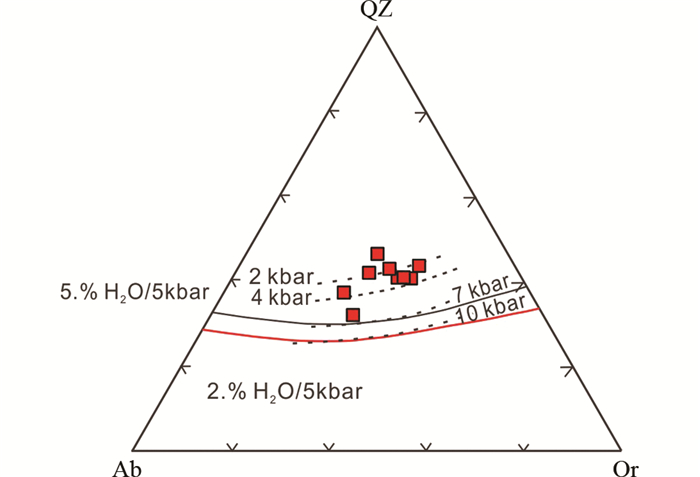
|
图 10 海德乌拉流纹岩Or-Qz-Ab图(虚线据Anderson and Bender, 1989;实线据Long et al., 1986) Fig. 10 Qz-Ab-Or diagram of the Haidewula rhyolite (dashed lines after Anderson and Bender, 1989; solid lines after Long et al., 1986) |
东昆仑造山带古生代岩浆岩记录了板块古生代俯冲增生作用。东昆仑造山带内发育了三条蛇绿糜棱岩带(Dong et al., 2018a):南带是慕士塔格-布青山-阿尼玛卿山蛇绿糜棱岩带(MBAM)、中带为阿其克库勒湖-昆中蛇绿糜棱岩带(AKM)、北带为祁漫塔格-香日德蛇绿糜棱岩带(QXM)。南带蛇绿岩和弧岩浆岩的成岩年龄介于535~437Ma之间,峰值为515Ma,其N-MORB蛇绿岩属性说明南带可能是东昆仑造山带主要缝合带(陈能松等, 2006; Li et al., 2007; Xiong et al., 2015; Zhou et al., 2016; 刘战庆等, 2011a, b );中带蛇绿岩和弧岩浆岩的成岩年龄峰值在440Ma左右,其SSZ-型蛇绿岩说明中带代表上俯冲带;北带蛇绿岩和弧岩浆岩的成岩年龄峰值在400Ma左右,E-MORB型蛇绿岩说明北带形成于弧后盆地。上述蛇绿岩和弧岩浆岩的年代学和地球化学特征说明了原特提斯洋为北向俯冲,俯冲作用起始于早寒武世,并一直延续至早志留世(如刘彬等, 2012, 如2013a, 如b ; Chen et al., 2020)。
海德乌拉流纹岩形成于426Ma,属于中志留世罗德洛世岩浆作用的产物。该流纹岩富含高场强元素和稀土元素且富碱,属于A型岩浆岩。研究表明,A型岩浆岩可以形成于一系列伸展环境下,如大陆弧后伸展环境、后碰撞伸展环境以及板内伸展环境(Eby, 1992; Whalen et al., 1996)。高Y/Nb比值(1.50~2.85)说明海德乌拉流纹岩为A2型流纹岩。在构造环境判别图中(图 11),海德乌拉A型火山岩落入后碰撞岩浆岩的范畴。近些年,在东昆仑造山带内厘定的一系列中志留世-泥盆纪A型岩浆岩(图 12, 陈静等, 2013; 王冠等, 2013; Xin et al., 2018; Chen et al., 2020),构成东昆仑造山带A型岩浆岩带(Chen et al., 2020)。这些A型岩浆岩属于后碰撞环境岩浆作用的产物(Xin et al., 2018; Chen et al., 2020),说明自中志留世开始东昆仑造山带已经进入了后碰撞伸展环境。
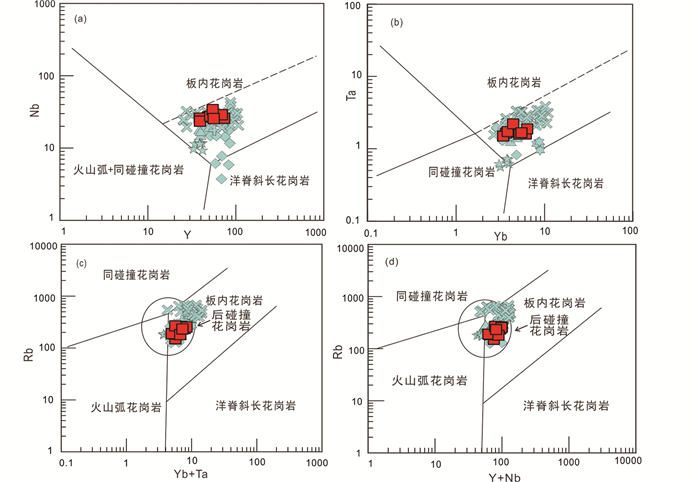
|
图 11 海德乌拉流纹岩构造环境判别图(据Pearce et al., 1984; Pearce, 1996) Fig. 11 Tectonic environment discrimination diagrams of the Haidewula rhyolite (after Pearce et al., 1984; Pearce, 1996) |
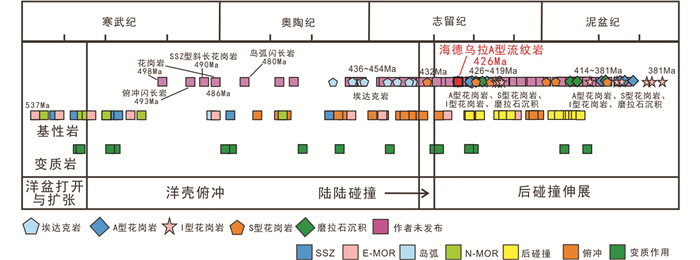
|
图 12 东昆仑造山带早古生代岩浆-变质-构造演化序列图(据刘彬等,2013b修改) 补充数据源自Dong et al. (2018a)和Xin et al. (2018) Fig. 12 Summary of Early Paleozoic magmatic-, metamorphic and tectonic evolution of East Kunlun Orogen (modified after Liu et al., 2013b) |
对于东昆仑造山带后碰撞伸展环境的触发机制依旧存在着不同的观点。部分学者认为,东昆仑造山带后碰撞环境是由于在祁漫塔格弧后洋盆闭合后中昆仑岛弧和柴达木板块碰撞所致(Zhou et al., 2016; Dong et al., 2018a)。然而,并没有足够证据证明在东昆仑造山带的东部地区曾经发育有类似于祁漫塔格地区的弧后洋盆,如东昆仑造山带中部和东部地区缺乏类似于祁漫塔格组的弧后沉积体系以及俯冲有关的岩浆岩,中部地区至今未发现蛇绿岩,东部地区存在的少量蛇绿岩可能仅仅反映的是原始的裂缝或者是非常有限的洋盆(Xin et al., 2018)。另有部分学者认为东昆仑造山带处于后碰撞造山伸展作用是由冈瓦纳大陆东北边缘的多板块汇聚后加厚岩石圈底部拆沉引发(Chen et al., 2020; Xin et al., 2018)。存在于南昆仑带志留纪赛什塘组与中泥盆世地层之间的断层(Dong et al., 2018a),证明原特提斯洋盆闭合后可能发生过陆-陆碰撞(Xin et al., 2018)。东昆仑造山带发育459~428Ma榴辉岩(Meng et al., 2013; 国显正等, 2017; Song et al., 2018)、448Ma的埃达克质花岗岩(Zhou et al., 2016)以及432Ma的S型花岗岩(Zheng et al., 2018),说明东昆仑造山带自中奥陶世-中志留世开始就处于陆-陆碰撞。事实上,前人研究已经表明早古生代时期冈瓦纳大陆北部延伸至古亚洲洋的南缘,包括东昆仑地块在内的中国主要陆块均分布于冈瓦纳大陆东北边缘(Li et al., 2018及其中的文献),这些陆块之间及其与冈瓦纳主大陆之间的碰撞形成一系列造山带,如北柴达木高压-超高压变质带(Yu et al., 2013a, b )、北祁连造山带(Song et al., 2013)等。综合考虑中央造山带西部祁连、柴达木、阿尔金和东昆仑地体中广泛发育的近于同时代的(志留纪-泥盆纪)与碰撞相关的花岗岩和高压-超高压变质岩,可以推断东昆仑地体在该时期也卷入了冈瓦纳大陆北缘一系列的碰撞造山事件。因此,可认为东昆仑造山带后碰撞伸展环境是由于冈瓦纳大陆东北边缘的板块汇聚后加厚岩石圈拆沉所致。
4.4 与铀成矿作用关系火山岩型铀矿床是指在成因和空间上与火山岩密切有关的热液脉型铀矿床。我国火山岩型铀矿床主要分布在中国东部地区,零星分布在河南、四川和云南等地。笔者通过对中国东部主要的铀矿酸性火山岩和次火山岩元素地球化学数据统计后发现,这些火山岩/次火山岩存在以下特征(表 4):(1)主量元素特征上,中国东部铀矿火山岩表现出富碱(K2O+Na2O中间值为8.79%)且相对富钾(K2O/Na2O中间值为1.89),弱过铝质-强过铝质特征(A/CNK中间值为1.05)、Fe#指数较高(中间值为0.93),属于铁质岩浆岩范畴;(2)微量元素组成上,中国东部铀矿火山岩富含高场强元素(Zr+Nb+Ce+Y中间值为642.47×10-6)和稀土元素(341.4×10-6),属于A型岩浆岩系列,成矿元素U(中间值为3.94×10-6)、Th(中间值为22.05×10-6)含量较高。与中国东部铀矿酸性火山岩/次火山岩类似,海德乌拉流纹岩同样显示出富碱且相对富钾、Fe#指数较高、富含高场强元素和稀土元素的A型岩浆岩特征。同时,相对于中国东部铀矿酸性(次)火山岩,海德乌拉火山岩具有更高的成矿元素含量(铀含量中间值为5.51×10-6,Th含量为28.58×10-6)。海德乌拉这些富铀的酸性火山岩能够为区内铀成矿提供充足的铀源(巫建华等, 2014)。
|
|
表 4 海德乌拉流纹岩和中国东部赋矿酸性火山岩中位值 Table 4 The median values of the Haidewula rhyolite and uranium deposit-host acid volcanic rocks in the eastern China |
(1) 东昆仑造山带海德乌拉流纹岩形成于426Ma,为志留纪罗德洛世岩浆活动的产物。
(2) 海德乌拉流纹岩显示A型岩浆岩的特征,可能在高温、中地壳压力由长英质火成岩熔融形成。
(3) 东昆仑造山带志留纪罗德洛世处于后碰撞环境,该后碰撞伸展环境可能是由于冈瓦纳大陆东北缘的板块汇聚后加厚岩石圈拆沉所致。
致谢 样品处理与实验测试得到了南京聚谱分析检测有限公司李亮和薛玮玮等人的指导和帮助;在修改文章的过程中得到陈加杰老师及两位匿名审稿老师的帮助;在此一并表示感谢。
Anderson JL and Bender EE. 1989. Nature and origin of Proterozoic A-type granitic magmatism in the southwestern United States of America. Lithos, 23(1-2): 19-52 DOI:10.1016/0024-4937(89)90021-2
|
Anderson JL and Cullers RL. 1978. Geochemistry and evolution of the Wolf River batholith, a Late Precambrian rapakivi massif in North Wisconsin, U.S.A. Precambrian Research, 7(4): 287-324 DOI:10.1016/0301-9268(78)90045-1
|
Bonin B. 2007. A-type granites and related rocks: Evolution of a concept, problems and prospects. Lithos, 97(1-2): 1-29 DOI:10.1016/j.lithos.2006.12.007
|
Bureau of Geology and Mineral Resources of Qinghai Province. 1991. Regional Geology of Qinghai Province. Beijing: Geological Publishing House, 1-604 (in Chinese)
|
Chappell BW. 1999. Aluminium saturation in I- and S-type granites and the characterization of fractionated haplogranites. Lithos, 46(3): 535-551 DOI:10.1016/S0024-4937(98)00086-3
|
Chen J, Xie ZY, Li B, Tan SX, Ren H, Zhang QM and Li Y. 2013. Pertogenesis of Devonian intrusive rocks in Lalingzaohuo area, eastern Kunlun, and its geological significance. Mineralogy and Petrology, 33(2): 26-34 (in Chinese with English abstract)
|
Chen JJ, Fu LB, Wei JH, Selby D, Zhang DH, Zhou HZ, Zhao X and Liu Y. 2020. Proto-Tethys magmatic evolution along northern Gondwana: Insights from Late Silurian-Middle Devonian A-type magmatism, East Kunlun Orogen, Northern Tibetan Plateau, China. Lithos, 356-357: 105304 DOI:10.1016/j.lithos.2019.105304
|
Chen NS, Li XY, Zhang KX, Wang GC, Zhu YH, Hou GJ and Bai YS. 2006. Lithological characteristics of the Baishahe formation to the south of Xiangride town, eastern Kunlun Mountains and its age constrained from zircon Pb-Pb dating. Geological Science and Technology Information, 25(6): 1-7 (in Chinese with English abstract)
|
Chen YX, Pei XZ, Li RB, Li ZC, Pei L, Chen GC, Liu CJ, Li XB and Yang J. 2013. Zircon U-Pb age, geochemical characteristics and tectonic significance of metavolcanic rocks from Naij Tal Group, east section of East Kunlun. Earth Science Frontiers, 20(6): 240-254 (in Chinese with English abstract)
|
Collins WJ, Beams SD, White AJR and Chappell BW. 1982. Nature and origin of A-type granites with particular reference to southeastern Australia. Contributions to Mineralogy and Petrology, 80: 189-200 DOI:10.1007/BF00374895
|
Creaser RA, Price RC and Wormald RJ. 1991. A-type granites revisited: Assessment of a residual-source model. Geology, 19(2): 163-166 DOI:10.1130/0091-7613(1991)019<0163:ATGRAO>2.3.CO;2
|
Dall'Agnol R, Scaillet B and Pichavant M. 1999. An experimental study of a Lower Proterozoic A-type granite from the eastern Amazonian Craton, Brazil. Journal of Petrology, 40(11): 1673-1698 DOI:10.1093/petroj/40.11.1673
|
Dall'Agnol R and de Oliveira DC. 2007. Oxidized, magnetite-series, rapakivi-type granites of Carajás, Brazil: Implications for classification and petrogenesis of A-type granites. Lithos, 93(3-4): 215-233 DOI:10.1016/j.lithos.2006.03.065
|
Dall'Agnol R, Frost CD and Räm OT. 2012. IGCP Project 510 "A-type Granites and Related Rocks through Time": Project vita, results, and contribution to granite research. Lithos, 151: 1-16 DOI:10.1016/j.lithos.2012.08.003
|
Dong GC, Luo MF, Mo XX, Zhao ZD, Dong LQ, Yu XH, Wang X, Li XW, Huang XF and Liu YB. 2018b. Petrogenesis and tectonic implications of Early Paleozoic granitoids in East Kunlun belt: Evidences from geochronology, geochemistry and isotopes. Geoscience Frontiers, 9(5): 1383-1397 DOI:10.1016/j.gsf.2018.03.003
|
Dong YP, He DF, Sun SS, Liu XM, Zhou XH, Zhang FF, Yang Z, Cheng B, Zhao GC and Li JH. 2018a. Subduction and accretionary tectonics of the East Kunlun orogen, western segment of the Central China Orogenic System. Earth-Science Reviews, 186: 231-261 DOI:10.1016/j.earscirev.2017.12.006
|
Eby GN. 1990. The A-type granitoids: A review of their occurrence and chemical characteristics and speculations on their petrogenesis. Lithos, 26(1-2): 115-134 DOI:10.1016/0024-4937(90)90043-Z
|
Eby GN. 1992. Chemical subdivision of the A-type granitoids: Petrogenetic and tectonic implications. Geology, 20(7): 641-644 DOI:10.1130/0091-7613(1992)020<0641:CSOTAT>2.3.CO;2
|
Feng CY, Zhang DQ, Wang FC, She HQ, Li DX and Wang Y. 2004. Multiple orogenic processes and geological characteristics of the major orogenic gold deposits in East Kunlun area, Qinghai Province. Acta Geoscientica Sinica, 25(4): 415-422 (in Chinese with English abstract)
|
Frost BR, Barnes CG, Collins WJ, Arculus RJ, Ellis DJ and Frost CD. 2001. A geochemical classification for granitic rocks. Journal of Petrology, 42(11): 2033-2048 DOI:10.1093/petrology/42.11.2033
|
Frost CD and Frost BR. 1997. Reduced rapakivi-type granites: The tholeiite connection. Geology, 25(7): 647 DOI:10.1130/0091-7613(1997)025<0647:RRTGTT>2.3.CO;2
|
Frost CD, Frost BR, Chamberlain KR and Edwards BR. 1999. Petrogenesis of the 1.43Ga Sherman batholith, SE Wyoming, USA: A reduced, rapakivi-type anorogenic granite. Journal of Petrology, 40(12): 1771-1802
|
Frost CD and Frost BR. 2011. On ferroan (A-type) granitoids: Their compositional variability and modes of origin. Journal of Petrology, 52(1): 39-53 DOI:10.1093/petrology/egq070
|
Glazner AF, Coleman DS and Bartley JM. 2008. The tenuous connection between high-silica rhyolites and granodiorite plutons. Geology, 36(2): 183-186 DOI:10.1130/G24496A.1
|
Griffin WL, Wang X, Jackson SE, Pearson NJ, O'Reilly SY, Xu XS and Zhou XM. 2002. Zircon chemistry and magma mixing, SE China: In-situ analysis of HF isotopes, Tonglu and Pingtan igneous complexes. Lithos, 61(3-4): 237-269 DOI:10.1016/S0024-4937(02)00082-8
|
Gu FB. 1994. Geological characteristics of East Kunlun and tectonic evolution in Late Palaezoic-Mesozoic ear. Geology in Qinghai, (1): 4-14 (in Chinese with English abstract)
|
Guo XZ, Jia QZ, Qian B, Mi JR, Li JC, Kong HL and Yao XG. 2017. Geochemical characteristics of eclogites and garnet-amphibolites in East Kunlun high pressure metamorphic belt and their geodynamic setting. Journal of Earth Sciences and Environment, 39(6): 735-750 (in Chinese with English abstract)
|
He DF, Dong YP, Zhang FF, Yang Z, Sun SS, Cheng B, Zhou B and Liu XM. 2016. The 1.0Ga S-type granite in the East Kunlun Orogen, Northern Tibetan Plateau: Implications for the Meso- to Neoproterozoic tectonic evolution. Journal of Asian Earth Sciences, 130: 46-59
|
Hildreth W. 2004. Volcanological perspectives on Long Valley, Mammoth Mountain, and Mono Craters: Several contiguous but discrete systems. Journal of Volcanology and Geothermal Research, 136(3-4): 169-198 DOI:10.1016/j.jvolgeores.2004.05.019
|
Hofmann AW, Jochum KP, Seufert M and White WM. 1986. Nb and Pb in oceanic basalts: New constraints on mantle evolution. Earth and Planetary Science Letters, 79(1-2): 33-45 DOI:10.1016/0012-821X(86)90038-5
|
Huang HQ, Li XH, Li WX and Li ZX. 2011. Formation of high δ18O fayalite-bearing A-type granite by high-temperature melting of granulitic metasedimentary rocks, southern China. Geology, 39(10): 903-906 DOI:10.1130/G32080.1
|
Jia XH, Wang Q and Tang GJ. 2009. A-type granites: Research progress and implications. Geotectonica et Metallogenia, 33(3): 465-480 (in Chinese with English abstract)
|
Jochum KP and Nohl U. 2008. Reference materials in geochemistry and environmental research and the GeoReM database. Chemical Geology, 253(1-2): 50-53 DOI:10.1016/j.chemgeo.2008.04.002
|
Kemp AIS, Hawkesworth CJ, Foster GL, Paterson BA, Woodhead JD, Hergt JM, Gray CM and Whitehouse MJ. 2007. Magmatic and crustal differentiation history of granitic rocks from Hf-O isotopes in zircon. Science, 315(5814): 980-983 DOI:10.1126/science.1136154
|
King PL, White AJR, Chappell BW and Allen CM. 1997. Characterization and origin of aluminous A-type granites from the Lachlan Fold Belt, southeastern Australia. Journal of Petrology, 38(3): 371-391 DOI:10.1093/petroj/38.3.371
|
Li RB, Pei XZ, Li ZC, Sun Y, Pei L, Chen GC, Chen YX, Liu CJ and Wei FH. 2013. Regional tectonic transformation in East Kunlun Orogenic Belt in Early Paleozoic: Constraints from the geochronology and geochemistry of Helegangnaren alkali-feldspar granite. Acta Geologica Sinica, 87(2): 333-345 DOI:10.1111/1755-6724.12054
|
Li SZ, Zhao SJ, Liu X, Cao HH, Yu S, Li XY, Somerville I, Yu SY and Suo YH. 2018. Closure of the Proto-Tethys Ocean and Early Paleozoic amalgamation of microcontinental blocks in East Asia. Earth Science Review, 186: 37-75 DOI:10.1016/j.earscirev.2017.01.011
|
Li WY, Li SG, Guo AL, Sun YG and Zhang GW. 2007. Zircon SHRIMP U-Pb ages and trace element geochemistry of the Kuhai gabbro and the Dur'ngoi diorite in the southern East Kunlun tectonic belt, Qinghai, western China and their geological implications. Science in China (Series D), 50: 331-338 DOI:10.1007/s11430-007-6003-4
|
Litvinovsky BA, Jahn BM, Zanvilevich AN, Saunders A, Poulain S, Kuzmin DV, Reichow MK and Titov AV. 2002. Petrogenesis of syenite-granite suites from the Bryansky complex (Transbaikalia, Russia): Implications for the origin of A-type granitoid magmas. Chemical Geology, 189(1-2): 105-133 DOI:10.1016/S0009-2541(02)00142-0
|
Liu B, Ma CQ, Zhang JY, Xiong FH, Huang J and Jiang HA. 2012. Petrogenesis of Early Devonian intrusive rocks in the east part of Eastern Kunlun Orogen and implication for Early Palaeozoic orogenic processes. Acta Petrologica Sinica, 28(6): 1785-1807 (in Chinese with English abstract)
|
Liu B, Ma CQ, Guo P, Zhang JY, Xiong FH, Huang J and Jiang HA. 2013a. Discovery of the Middle Devonian A-type granite from the eastern Kunlun orogen and its tectonic implications. Earth Science, 38(5): 947-962 (in Chinese with English abstract)
|
Liu B, Ma CQ, Jiang HA, Guo P, Zhang JY and Xiong FH. 2013b. Early Paleozoic tectonic transition from ocean subduction to collisional orogeny in the Eastern Kunlun region: Evidence from Huxiaoqin mafic rocks. Acta Petrologica Sinica, 29(6): 2093-2106 (in Chinese with English abstract)
|
Liu YS, Hu ZC, Zong KQ, Gao CG, Gao S, Xu J and Chen HH. 2010. Reappraisement and refinement of zircon U-Pb isotope and trace element analyses by LA-ICP-MS. Chinese Science Bulletin, 55(15): 1535-1546 DOI:10.1007/s11434-010-3052-4
|
Liu ZQ, Pei XZ, Li RB, Li ZC, Chen GC, Chen YX, Gao JM, Liu CJ, Wei FH, Wang XL and Zhang G. 2011a. Early Paleozoic intermediate-acid magmatic activity in Bairiqiete area along the Buqingshan tectonic mélange belt on the southern margin of East Kunlun: Constraints from zircon U-Pb dating and geochemistry. Geology in China, 38(5): 1150-1167 (in Chinese with English abstract)
|
Liu ZQ, Pei XZ, Li RB, Li ZC, Chen YX, Gao JM, Liu CJ, Wang XL, Wei FG, Zhang G and Yang ZZ. 2011b. Geological characteristics of the Buqingshan tectonic mélange belt in the southern margin of East Kunlun and its tectonic implications. Geological Bulletin of China, 30(8): 1182-1195 (in Chinese with English abstract)
|
Loiselle MC and Wones DR. 1979. Characteristics and origin of an orogenic granites. Geology Society of American Abstract Program, 11: 468
|
Long LE, Sial AN, Nekvasil H and Borba GS. 1986. Origin of granite at Cabo de Santo Agostinho, Northeast Brazil. Contributions to Mineralogy and Petrology, 92: 341-350 DOI:10.1007/BF00572163
|
Lopez S and Castro A. 2001. Determination of the fluid-absent solidus and supersolidus phase relationships of MORB-derived amphibolites in the range 4~14kbar. American Mineralogist, 86: 1396-1403 DOI:10.2138/am-2001-11-1208
|
Maniar PD and Piccoli PM. 1989. Tectonic discrimination of granitoids. Geological Society of America Bulletin, 101(5): 635-643 DOI:10.1130/0016-7606(1989)101<0635:TDOG>2.3.CO;2
|
McDonough WF and Sun SS. 1995. The composition of the Earth. Chemical Geology, 120(3-4): 223-253 DOI:10.1016/0009-2541(94)00140-4
|
Meng FC, Zhang JX and Cui MH. 2013. Discovery of Early Paleozoic eclogite from the East Kunlun, western China and its tectonic significance. Gondwana Research, 23(2): 825-836 DOI:10.1016/j.gr.2012.06.007
|
Molnar P, Burchfiel BC, Liang KY and Zhao ZY. 1987a. Geomorphic evidence for active faulting in the Altyn Tagh and northern Tibet and qualitative estimates of its contribution to the convergence of India and Eurasia. Geology, 15: 249-253 DOI:10.1130/0091-7613(1987)15<249:GEFAFI>2.0.CO;2
|
Molnar P, Burchfiel BC, Zhao Z, Liang KY, Wang SJ and Huang MM. 1987b. Geologic evolution of Northern Tibet: Results of an expedition to Ulugh Muztagh. Science, 235(4786): 299-305 DOI:10.1126/science.235.4786.299
|
Patiño Douce AE. 1997. Generation of metaluminous A-type granites by low-pressure melting of calc-alkaline granitoids. Geology, 25: 743-746 DOI:10.1130/0091-7613(1997)025<0743:GOMATG>2.3.CO;2
|
Patiño Douce AE. 1999. What do experiments tell us about the relative contributions of crust and mantle to the origin of granitic magmas?. Geological Society, London, Special Publications, 168(1): 55 DOI:10.1144/GSL.SP.1999.168.01.05
|
Patiño Douce AE. 2004. Vapor-absent melting of tonalite at 15~32kbar. Journal of Petrology, 46(2): 275-290 DOI:10.1093/petrology/egh071
|
Pearce JA, Harris NBW and Tindle AG. 1984. Trace element discrimination diagrams for the tectonic interpretation of granitic rocks. Journal of Petrology, 25(4): 956-983 DOI:10.1093/petrology/25.4.956
|
Pearce JA. 1996. Sources and settings of granitic rocks. Episodes, 19(4): 120-125 DOI:10.18814/epiiugs/1996/v19i4/005
|
Peccerillo A and Taylor SR. 1976. Geochemistry of Eocene calc-alkaline volcanic rocks from the Kastamonu area, Northern Turkey. Contributions to Mineralogy and Petrology, 58(1): 63-81 DOI:10.1007/BF00384745
|
Petcovic HL and Grunder AL. 2003. Textural and thermal history of partial melting in tonalitic wallrock at the margin of a basalt dike, Wallowa Mountains, Oregon. Journal of Petrology, 44(12): 2287-2312 DOI:10.1093/petrology/egg078
|
Qian Q and Hermann J. 2013. Partial melting of lower crust at 10~15kbar: Constraints on adakite and TTG formation. Contributions to Mineralogy and Petrology, 165: 1195-1224 DOI:10.1007/s00410-013-0854-9
|
Rapp RP and Watson EB. 1995. Dehydration melting of metabasalt at 8~32kbar: Implications for continental growth and crust-mantle recycling. Journal of Petrology, 36(4): 891-931 DOI:10.1093/petrology/36.4.891
|
Roger F, Arnaud N, Gilder S, Tapponnier P, Jolivet M, Brunel M, Malavieille J, Xu ZQ and Yang JS. 2003. Geochronological and geochemical constraints on Mesozoic suturing in east central Tibet. Tectonics, 22(4): 1037
|
Sen C and Dunn T. 1994. Dehydration melting of a basaltic composition amphibolite at 1.5 and 2.0GPa: Implications for the origin of adakites. Contributions to Mineralogy and Petrology, 117: 394-409 DOI:10.1007/BF00307273
|
Şengör AMC. 1979. Mid-Mesozoic closure of Permo-Triassic Tethys and its implications. Nature, 279(5714): 590-593 DOI:10.1038/279590a0
|
Shi B. 2014. The genesis of the Caledonian peraluminous granites in Heihai region, the Eastern Kunlun. Ph. D. Dissertation. Wuhan: China University of Geosciences, 1-113 (in Chinese with English abstract)
|
Skjerlie KP and Johnston AD. 1992. Vapor-absent melting at 10kbar of a biotite- and amphibole-bearing tonalitic gneiss: Implications for the generation of A-type granites. Geology, 20: 263-266 DOI:10.1130/0091-7613(1992)020<0263:VAMAKO>2.3.CO;2
|
Skjerlie KP and Patino Douce AE. 2002. The fluid-absent partial melting of a zoisite-bearing quartz eclogite from 1.0 to 3.2GPa: Implications for melting in thickened continental crust and for subduction-zone processes. Journal of Petrology, 43(2): 291-314
|
Song SG, Niu YL, Su L and Xia XH. 2013. Tectonics of the North Qilian Orogen, NW China. Gondwana Research, 23(4): 1378-1401 DOI:10.1016/j.gr.2012.02.004
|
Song SG, Bi HZ, Qi SS, Yang LM, Allen MB, Niu YL, Su L and Li WF. 2018. HP-UHP metamorphic belt in the East Kunlun Orogen: Final closure of the Proto-Tethys Ocean and formation of the Pan-North-China Continent. Journal of Petrology, 59(11): 2043-2060 DOI:10.1093/petrology/egy089
|
Sun Y, Ma CQ, Liu YY and She ZB. 2011. Geochronological and geochemical constraints on the petrogenesis of Late Triassic aluminous A-type granites in Southeast China. Journal of Asian Earth Sciences, 42(6): 1117-1131 DOI:10.1016/j.jseaes.2011.06.007
|
Turner SP, Foden JD and Morrison RS. 1992. Derivation of some A-type magmas by fractionation of basaltic magma: An example from the Padthaway Ridge, South Australia. Lithos, 28(2): 151-179 DOI:10.1016/0024-4937(92)90029-X
|
Wang G, Sun FY, Li BL, Li SJ, Zhao JW, Yang QA and Ao C. 2013. Zircon U-Pb geochronology and geochemistry of the Early Devonian Syenogranite in the Xiarihamu ore district from east Kunlun, with implications for the geodynamic setting. Geotectonica et Metallogenia, 37(4): 685-697 (in Chinese with English abstract)
|
Wang KX, Sun T, Chen PR, Ling HF and Xiang TF. 2013. The geochronological and geochemical constraints on the petrogenesis of the Early Mesozoic A-type granite and diabase in northwestern Fujian Province. Lithos, 179: 364-381 DOI:10.1016/j.lithos.2013.07.016
|
Watkins JM, Clemens JD and Treloar PJ. 2007. Archaean TTGs as sources of younger granitic magmas: Melting of sodic metatonalites at 0.6~1.2GPa. Contributions to Mineralogy and Petrology, 154: 91-110 DOI:10.1007/s00410-007-0181-0
|
Watson EB and Harrison TM. 1983. Zircon saturation revisited: Temperature and composition effects in variety of crustal magma types. Earth and Planetary Science Letters, 64(2): 295-304 DOI:10.1016/0012-821X(83)90211-X
|
Whalen JB, Currie KL and Chappell BW. 1987. A-type granites: Geochemical characteristics, discrimination and petrogenesis. Contributions to Mineralogy and Petrology, 95(4): 407-419 DOI:10.1007/BF00402202
|
Whalen JB, Jenner GA, Frederick J, Longstaffe and Ernst H. 1996. Nature and evolution of the eastern margin of lapetus: Geochemical and isotopic constraints from Siluro-Devonian granitoid plutons in the New Brunswick Appalachians. Canadian Journal of Earth Sciences, 33(2): 140-155 DOI:10.1139/e96-014
|
Wu FY, Sun DY, Li HM, Jahn BM and Wilde S. 2002. A-type granites in Northeastern China: Age and geochemical constraints on their petrogenesis. Chemical Geology, 187(1-2): 143-173 DOI:10.1016/S0009-2541(02)00018-9
|
Wu JH, Xie KR, Wu RG, Guo GL and Liu S. 2014. The new progress in the study of Mesozoic rhyolite-trachyte assemblage and hydrothermal-type uranium mineralization in eastern China. Advances in Earth Science, 29(12): 1372-1382 (in Chinese with English abstract)
|
Wu JH, Lao YJ, Xie GF, Zhang JY, Wu RG and Nie FJ. 2017. Stratigraphy and geochronology of the volcanic rocks in the Xiangshan uranium orefield, Jiangxi Province and its geological implications. Geology in China, 44(5): 974-992 (in Chinese with English abstract)
|
Wu YB and Zheng YF. 2004. A study on the genetic mineralogy of zircon and its restriction on the interpretation of U-Pb age. Chinese Science Bulletin, 49(16): 1589-1604 (in Chinese) DOI:10.1360/csb2004-49-16-1589
|
Xiao L and Clemens JD. 2007. Origin of potassic (C-type) adakite magmas: Experimental and field constraints. Lithos, 95(3-4): 399-414 DOI:10.1016/j.lithos.2006.09.002
|
Xin W, Sun FY, Li L, Yan JM, Zhang YT, Wang YC, Shen TS and Yang YJ. 2018. The Wulonggou metaluminous A2-type granites in the Eastern Kunlun Orogenic Belt, NW China: Rejuvenation of subduction-related felsic crust and implications for post-collision extension. Lithos, 312-313: 108-127 DOI:10.1016/j.lithos.2018.05.005
|
Xiong FH, Ma CQ, Wu L, Jiang HA and Liu B. 2015. Geochemistry, zircon U-Pb ages and Sr-Nd-Hf isotopes of an Ordovician appinitic pluton in the East Kunlun orogen: New evidence for Proto-Tethyan subduction. Journal of Asian Earth Sciences, 111: 681-697 DOI:10.1016/j.jseaes.2015.05.025
|
Xu ZQ, Yang JS, Li HB and Yao JX. 2006. The Early Palaeozoic Terrene framework and the formation of the High-Pressure (HP) and Ultra-High Pressure (UHP) metamorphic belts at the Central Orogenic Belt (COB). Acta Geologica Sinica, 80(12): 1793-1806 (in Chinese with English abstract)
|
Yan W, Qiu DM, Ding QF and Liu F. 2016. Geochronology, petrogenesis, source and its structural significance of Houtougou monzogranite of Wulonggou area in Eastern Kunlun Orogen. Journal of Jilin University (Earth Science Edition), 46(2): 443-460 (in Chinese with English abstract)
|
Yang JH, Wu FY, Chung SL, Wilde SA and Chu MF. 2006. A hybrid origin for the Qianshan A-type granite, Northeast China: Geochemical and Sr-Nd-Hf isotopic evidence. Lithos, 89(1-2): 89-106 DOI:10.1016/j.lithos.2005.10.002
|
Yin A and Harrison TM. 2000. Geologic evolution of the Himalayan-Tibetan orogen. Annual Review of Earth and Planetary Sciences, 28: 211-280 DOI:10.1146/annurev.earth.28.1.211
|
Yu SY, Zhang JX, Del Real PG, Zhao XL, Hou KJ, Gong JH and Li YS. 2013a. The Grenvillian orogeny in the Altun-Qilian-North Qaidam mountain belts of northern Tibet Plateau: Constraints from geochemical and zircon U-Pb age and Hf isotopic study of magmatic rocks. Journal of Asian Earth Sciences, 73: 372-395 DOI:10.1016/j.jseaes.2013.04.042
|
Yu SY, Zhang JX, Li HK, Hou KJ, Mattinson CG and Gong JH. 2013b. Geochemistry, zircon U-Pb geochronology and Lu-Hf isotopic composition of eclogites and their host gneisses in the Dulan area, North Qaidam UHP terrane: New evidence for deep continental subduction. Gondwana Research, 23(3): 901-919 DOI:10.1016/j.gr.2012.07.018
|
Zhao KD, Jiang SY, Chen WF, Chen PR and Ling HF. 2013. Zircon U-Pb chronology and elemental and Sr-Nd-Hf isotope geochemistry of two Triassic A-type granites in South China: Implication for petrogenesis and Indosinian transtensional tectonism. Lithos, 160-161: 292-306 DOI:10.1016/j.lithos.2012.11.001
|
Zheng Z, Chen YJ, Deng XH, Yue SW, Chen HJ and Wang QF. 2018. Origin of the Bashierxi monzogranite, Qiman Tagh, East Kunlun Orogen, NW China: A magmatic response to the evolution of the Proto-Tethys Ocean. Lithos, 296-299: 181-194 DOI:10.1016/j.lithos.2017.10.019
|
Zhou B, Dong YP, Zhang FF, Yang Z, Sun SS and He DF. 2016. Geochemistry and zircon U-Pb geochronology of granitoids in the East Kunlun Orogenic Belt, northern Tibetan Plateau: Origin and tectonic implications. Journal of Asian Earth Sciences, 130: 265-281 DOI:10.1016/j.jseaes.2016.08.011
|
Zhou YY, Zhai MG, Zhao TP, Lan ZW and Sun QY. 2014. Geochronological and geochemical constraints on the petrogenesis of the Early Paleoproterozoic potassic granite in the Lushan area, southern margin of the North China Craton. Journal of Asian Earth Sciences, 94: 190-204 DOI:10.1016/j.jseaes.2014.03.003
|
Zhu YH, Zhu YS, Lin QX and Wang GC. 2003. Characteristics of Early Jurassic volcanic rocks and their tectonic significance in Haidewula, East Kunlun Orogenic Belt, Qinghai Province. Earth Science, 28(6): 653-659 (in Chinese with English abstract)
|
陈静, 谢智勇, 李彬, 谈生祥, 任华, 张启梅, 李燕. 2013. 东昆仑拉陵灶火地区泥盆纪侵入岩成因及其地质意义. 矿物岩石, 33(2): 26-34. |
陈能松, 李晓彦, 张克信, 王国灿, 朱云海, 侯光久, 拜永山. 2006. 东昆仑山香日德南部白沙河岩组的岩石组合特征和形成年代的锆石Pb-Pb定年启示. 地质科技情报, 25(6): 1-7. DOI:10.3969/j.issn.1000-7849.2006.06.001 |
陈有炘, 裴先治, 李瑞保, 李佐臣, 裴磊, 陈国超, 刘成军, 李小兵, 杨杰. 2013. 东昆仑东段纳赤台岩群变火山岩锆石U-Pb年龄、地球化学特征及其构造意义. 地学前缘, 20(6): 240-254. |
丰成友, 张德全, 王富春, 佘宏全, 李大新, 王彦. 2004. 青海东昆仑复合造山过程及典型造山型金矿地质. 地球学报, 25(4): 415-422. DOI:10.3321/j.issn:1006-3021.2004.04.005 |
古凤宝. 1994. 东昆仑地质特征及晚古生代——中生代构造演化. 青海地质, (1): 4-14. |
国显正, 贾群子, 钱兵, 弥佳茹, 李金超, 孔会磊, 姚学钢. 2017. 东昆仑高压变质带榴辉岩和榴闪岩地球化学特征及形成动力学背景. 地球科学与环境学报, 39(6): 735-750. DOI:10.3969/j.issn.1672-6561.2017.06.005 |
贾小辉, 王强, 唐功建. 2009. A型花岗岩的研究进展及意义. 大地构造与成矿学, 33(3): 465-480. DOI:10.3969/j.issn.1001-1552.2009.03.017 |
刘彬, 马昌前, 张金阳, 熊富浩, 黄坚, 蒋红安. 2012. 东昆仑造山带东段早泥盆世侵入岩的成因及其对早古生代造山作用的指示. 岩石学报, 28(06): 1785-1807. |
刘彬, 马昌前, 郭盼, 张金阳, 熊富浩, 黄坚, 蒋红安. 2013a. 东昆仑中泥盆世A型花岗岩的确定及其构造意义. 地球科学, 38(5): 947-962. |
刘彬, 马昌前, 蒋红安, 郭盼, 张金阳, 熊富浩. 2013b. 东昆仑早古生代洋壳俯冲与碰撞造山作用的转换: 来自胡晓钦镁铁质岩石的证据. 岩石学报, 29(6): 2093-2106. |
刘战庆, 裴先治, 李瑞保, 李佐臣, 陈国超, 陈有炘, 高景民, 刘成军, 魏方辉, 王学良, 张刚. 2011a. 东昆仑南缘布青山构造混杂岩带早古生代白日切特中酸性岩浆活动: 来自锆石U-Pb测年及岩石地球化学证据. 中国地质, 38(5): 1150-1167. |
刘战庆, 裴先治, 李瑞保, 李佐臣, 陈有炘, 高景民, 刘成军, 王学良, 魏方辉, 张刚, 杨忠智. 2011b. 东昆仑南缘布青山构造混杂岩带的地质特征及大地构造意义. 地质通报, 30(8): 1182-1195. |
青海省地质矿产局. 1991. 青海省区域地质志. 北京: 地质出版社, 1-604.
|
施彬. 2014. 东昆仑黑海地区加里东期过铝质花岗岩成因研究. 博士学位论文. 武汉: 中国地质大学, 1-113
|
王冠, 孙丰月, 李碧乐, 李世金, 赵俊伟, 杨启安, 奥琮. 2013. 东昆仑夏日哈木矿区早泥盆世正长花岗岩锆石U-Pb年代学、地球化学及其动力学意义. 大地构造与成矿学, 37(4): 685-697. |
巫建华, 解开瑞, 吴仁贵, 郭国林, 刘帅. 2014. 中国东部中生代流纹岩-粗面岩组合与热液型铀矿研究新进展. 地球科学进展, 29(12): 1372-1382. |
巫建华, 劳玉军, 谢国发, 张婧妍, 吴仁贵, 聂逢君. 2017. 江西相山铀矿田火山岩系地层学、年代学特征及地质意义. 中国地质, 44(5): 974-992. |
吴元保, 郑永飞. 2004. 锆石成因矿物学研究及其对U-Pb年龄解释的制约. 科学通报, 49(16): 1589-1604. DOI:10.3321/j.issn:0023-074X.2004.16.002 |
许志琴, 杨经绥, 李海兵, 姚建新. 2006. 中央造山带早古生代地体构架与高压/超高压变质带的形成. 地质学报, 80(12): 1793-1806. DOI:10.3321/j.issn:0001-5717.2006.12.002 |
严威, 邱殿明, 丁清峰, 刘飞. 2016. 东昆仑五龙沟地区猴头沟二长花岗岩年龄、成因、源区及其构造意义. 吉林大学学报(地球科学版), 46(2): 443-460. |
朱云海, 朱耀生, 林启祥, 王国灿. 2003. 东昆仑造山带海德乌拉一带早侏罗世火山岩特征及其构造意义. 地球科学, 28(6): 653-659. DOI:10.3321/j.issn:1000-2383.2003.06.011 |
 2021, Vol. 37
2021, Vol. 37








